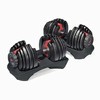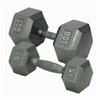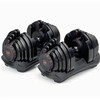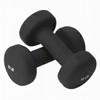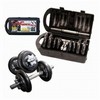Buying Advice: Dumbbells
Dumbbells are relatively inexpensive when it comes to exercise equipment, but they are truly the foundation of any good home gym. Incorporating dumbbell workouts into your routine is an easy and effective way to trim and tone your whole body, as well as build muscle strength and endurance. Since they offer more free range of motion than barbells or weight machines, they are more versatile and allow you to work out multiple muscles groups at the same time. Depending on the type of dumbbells and the different weight resistances you have available, you can perform almost any workout routine without ever leaving home. To help you find the right dumbbells for your individual needs and budget, we have put together some important points below to keep in mind while you are shopping.
What to Know Before You Buy
Types of Dumbbells: Fixed-Weight vs. Adjustable
Dumbbells are either fixed-weight dumbbells or adjustable dumbbells. Fixed-weight dumbbells are the traditional style dumbbells that you would see in a commercial gym. They are available in numerous weight resistances ranging from 1 pound to over 100 pounds (sold individually or as a pair), and they are typically stored on a rack or simply on the floor depending on what you have. Fixed-weight dumbbells can be less expensive than adjustable sets on a per pound basis, and they are very convenient if you like to do speed circuits or P90x where you need to be able to change out weights quickly. These dumbbells also tend to be safer and more durable than their adjustable counterparts. One major drawback of fixed-weight dumbbells, however, is that they can take up a lot of space depending on how many pairs you decide to purchase. Also, if you are planning on buying a lot of different weight resistances, the cost advantage may start to shift in favor of adjustable dumbbells.
Adjustable dumbbells allow you to add/remove weight plates from just one pair of dumbbells. So, if you don't have a lot of space, adjustable dumbbells are generally the perfect way to get all the benefits of a dumbbell set without the clutter. Their compact size also makes them easy to transport if, for example, you sometimes like to take your dumbbells to the office. You can find a lightweight set that has weight settings as low as 1 – 10 pounds (per dumbbell) and that are adjustable in 0.5- or 1-pound increments. Popular mid-weight sets can be between 5 – 20 or even 5 – 55 pounds (per dumbbell), but they can usually only be adjusted in 2.5- or 5-pound increments. For heavier lifting, you can find sets that offer weight resistances between 5 – 125 pounds (per dumbbell). Some models will allow weight adjustments in 2.5- and 5-pound increments, but others only offer adjustments in 10-pound increments. In addition to having a space-saving design, adjustable dumbbells can also be more cost effective than buying individual fixed-weight dumbbells if you want to have a lot of weight resistance options. The next section will take a closer look at the advantages and disadvantages of the two main adjustable dumbbell styles.
Types of Adjustable Dumbbells
If you decide you are interested in adjustable dumbbells, you will be choosing between two main styles including ones that have clips or collars (ex. spinlock) to secure the weight plates to the handle and selectorized ones that change weights using a pin and/or dial adjustment system. With the first style, the clip or collar has to be manually removed and then retightened each time you want to add or remove weight plates. These adjustable dumbbells can be very inexpensive and include some great mid-weight sets like the CAP Barbell 40-pound one that costs around $30 and has 7 different weight settings. However, they also have a few drawbacks. There is the possibility that the tightening mechanisms could start to loosen over time (especially on the less expensive models) and the dumbbells may become hazardous to use for exercises where they will be suspended over your head. Additionally, the process to add/remove weight plates is very time-consuming, so this style of adjustable dumbbell isn't ideal if you are interested in doing speed circuits. While less common, some sets even require a tool to change weights, which has the potential to be even more inconvenient if you end up losing the tool.
Selectorized dumbbells (ex. Bowlfex® SelectTech® or PowerBlocks) are the most expensive style of adjustable dumbbells, but they have a more automatic adjustment system that allows you to change weights simply by moving a pin or turning a dial. Since adjusting the weight resistance is faster, this style of dumbbell offers you the versatility and speed of a fixed-weight dumbbell set in your workouts without taking up hardly any space. Selectorized dumbbells tend to offer heavier weight options, so we highly suggest purchasing a rack for them (if they don't already come with one) because lifting them off the ground could lead to a back injury. Safety concerns regarding the locking mechanism have also been reported with selectorized dumbbells (ex. Bowlfex® SelectTech® 1090s), so you want to check it ever so often and exercise caution when lifting the weights above your head.
Construction Materials
Dumbbells can be manufactured using chrome, cast iron, concrete or sand. While the weights will be the same across the board, the material that is used will have a significant impact on the dumbbells' durability and the number of weight resistance options you have. Solid chrome dumbbells are on the higher end of the cost spectrum, but they will offer the widest range of weight resistances. They are also the most durable and have a naturally bright and shiny metal exterior. Less expensive dumbbells that you will come across are usually cast iron and can be coated with a glossy finish or with rubber or neoprene. The cheapest and, not surprisingly, least durable dumbbells can be made with concrete or sand and will have a plastic, rubber or neoprene shell. Depending on the weight resistance and weight material, some people may prefer neoprene/rubber coated dumbbells because they can be dropped on the floor without making a lot of noise or damaging any surfaces.
Dumbbell Design: Shape, Handles and Grip
Unless your dumbbells come with a specially designed storage case or rack, the shape of their weight plates is another important factor to consider. Round dumbbells will roll around when set down, so we suggest looking for dumbbells with even a slightly square, hexagon or octagon shape because the edges will keep the dumbbell in place no matter where you put it.
In terms of handles, dumbbells will have different styles to suit different people's preferences and workout styles. The bar could have a round or oval shape, and it could also have a straight or contoured (ergonomic) design. Contoured handles offer a more secure and comfortable grip, and the design is especially nice when lifting heavier weights because it helps to reduce forearm and finger fatigue.
Grips on metal handles that are etched with a knurled (ie. cross-hatching) pattern will feel the most secure, particularly with heavier weights, but lighter weights with rubber or neoprene handles (ex. Valeo hand weights) will be okay for ladies who are worried about calluses and/or prefer a softer grip. Keep in mind, however, that smooth or coated handles can become slippery if your hands start to sweat when using them. It's hard to say what handle will be most comfortable for you, so, if you aren't sure what you want, your best bet is to stop by a sports equipment store to try out a few styles.
How Many Different Weight Resistances Do You Need?
The number of weight resistances you'll need is entirely personal and will depend on your current fitness level and the types of activities you want to do. If you are an average-size woman looking to trim and tone, you should begin with a couple of different resistance options under 15 pounds. Ideally, we'd suggest stocking up on 2-, 5-, 8-, 10-, 12- and 15-pounders to get started. As you get into better shape, you can think about adding 20- and 25-pound weights to your routine (or heavier!). If you are average-size man looking to strength and build muscle endurance, you'll want to start off with weights ranging from at least 10-35 pounds (in 5-pound increments) and eventually add at least 40-, 45- and 50-pound weights as you get stronger. For most guys or couples looking to get in shape together, the most compact and cost effective dumbbells for your home gym are probably adjustable dumbbells like the Bowflex® SelectTech® 552 (about $349) that have weight resistances ranging from 5 pounds to 52.5 pounds. Another way to add different weight resistances to your current dumbbell set without breaking the bank is by purchasing magnetic weight plates that attach to the end of the dumbbell. They allow you to increase weight in extremely small increments from as little as a half of a pound up to 5 pounds. Safety is really the only big concern with magnetic weight plates, and, while they are on your dumbbells, you really shouldn't use them to do things like pullovers or overhead tricep extensions.####
Conclusion
When buying dumbbells, you should be thinking about your current fitness level, the type of workouts you want to do, the results you’d eventually like to achieve and your budget. If you can afford them and have enough space, we recommend purchasing fixed-weight dumbbells since they are safer and make it easy to change out weights during your workout. However, adjustable dumbbells can be more cost effective in certain cases and are convenient if you don’t have a lot of space for workout equipment. Regardless of which dumbbell set you buy, we also highly suggest purchasing a workout bench because it will help to enhance the effectiveness and versatility of the dumbbells and your workout routine overall.

